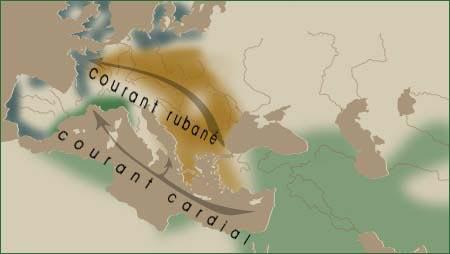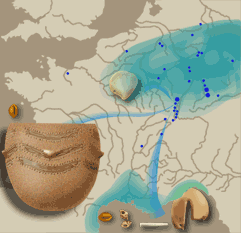- Home
- Discover the megaliths of Morbihan
- The Neolithic period
- A New Way of Life
Diffusion of the ribbon and cardial currents.
The introduction of farming and stock-breeding characterized the Neolithic Age. These techniques emerged in different parts of the world (Central America, Sub-Saharan Africa, South-East Asia, the Nile Valley and the Near East) at different times. These areas combined a warm and sunny climate, plenty of water, edible plants and easily domesticated animals. In the Near East the particularly favorable conditions found in the "Fertile Crescent" encouraged the gradual adoption of this way of life from the 8th millennium onwards. These conditions included :
- much warmer climatic conditions after the glacial period,
- the existence of alluvial plains in the major Mesopotamian river valleys,
- indigenous plants with highly nourishing and easy-to-gather seeds (wheat, wild barley, leguminous plants),
- large numbers of indigenous wild sheep and goats as well as wild oxen (aurochs) and boars.
The Neolithic way of life spread rapidly westward from this core area towards Turkey and the Balkans and then onwards into Europe along two routes:
- the alluvial plains of Central Europe ("Danubian" culture and "Bandkeramik" ceramics);
- the Mediterranean coast ( "cardial" ceramic culture).
In the second half of the 6th millennium B.C., the "Bandkeramik" culture reached the Alsace area, and the "cardial" culture reached the Provence and Languedoc coastline.
These cultures finally came into contact and influenced each other within the boundaries of present-day France. Traces of both cultures dating from the beginning of the 5th millennium B.C. have been found in the Basse-Loire area and in eastern and southern Brittany.
These early farmers, especially those belonging to the "Bandkeramik" culture were not keen hunters. Domestic waste found in Paris Basin sites shows that game often represented less than 20% of animal remains.
On the edges of the newly settled areas, Neolithic farmers came into contact with the Mesolitihic hunters, some of whom adopted the art of ceramics, while others acquired domestic animals (by bartering or raiding). In exchange, the Neolithic people acquired ornaments originating from outside their territory. Some scientists see a link between these contacts and the rise of megalithism.
Neolithic farmers used rudimentary but well established techniques:
- land clearance by burning (after saving usable timber);
- ard-ploughs could have been used, at least in certain areas and for heavy work;
- fodder storage capacities were reduced, so only breeding stock was kept in winter (which may have contributed to accelerate the "genetic drift" from wild strains).
People settled more or less permanently and banded together at regular intervals to carry out work. This helped to build more elaborate social structures and led to the emergence of leaders and people with a specific know-how. A strong sense of community linked to the recognition of privilege and lineage affected funerary practices, the perception of the sacred and the definition of collective identities.
Some clues of the contacts made by the first peasants of Western Europe.
Middle dolerite plywood, Middle Neolithic Saint-Joachim (Loire-Atlantique).



